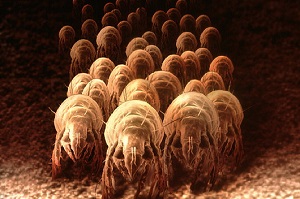Why do dust mites like living alongside humans?
Dust mite populations love human houses for a few reasons – shed human skin (a major food source that is plentiful), but perhaps more important to dust mites is the humidity in bedding created by the (roughly) one litre of moisture lost by adults each night.
Dust mites are very sensitive to aridity and use the 8hr sleep period of humans to absorb the water that they need through their skin and by secreting and then ingesting a water-absorbing fluid. When we’re in bed, dust mites migrate towards us to absorb moisture from our perspiration and breath. Mercifully, dust mites don’t crawl all over us because we’re too hot to be comfortable for them.
One theory that attempts to explain the rising numbers of allergy sufferers worldwide is that modern houses are more humid, warmer, and less ventilated and are more accommodating to dust mite populations than in the past.
Dust Mite Diet
Human skin scales (your body sheds 3.6kg of dead skin per year) , shed pet skin (dander), food residues, pollen, grains, mould and feathers. The dust mites eat organic matter that has already been partially decomposed by fungi. Human households have some or all of these food sources in abundance.
Dust Mite’s Favoured Environment
- Humidity and uncirculated air – Humidity between 60 to 80%
- Temp 15-20 C
- Absence of direct sunlight.
| Dust Mites Love Heavily Used (lots of skin contact) Soft Furnishings: | |
|---|---|
|
|
Apparel:
| General:
|
Read More on Dust Mites: What are Dust Mites? A Major Allergy Villian
Dust Mite References:
Sydney Children’s Hospital Randwick – Dust Mite Factsheet
Entomology Department, University of Florida
Euroglyphus Maynei – Thermo Scientific
Thomas, Wayne R., Wendy-Anne Smith, Belinda J. Hales, Kristina L. Mills, and Richard M.O’Brien. “Characterization and Immunobiology of House Dust Mite Allergens.” International Archives of Allergy and Immunology 129.1 (2002): 1-18. Print.
Boquete, M., Iraola, V., Fern\’, ez-Caldas, E., Villaroel, L., Carballada, F., de la Cuesta, C., Lopez-Rico, M., Orjales, R., Parra, A., Soto-Mera, M. and others, (2006). House dust mite species and allergen levels in Galicia, Spain: a cross-sectional, multicenter, comparative study. Journal of Investigational Allergology and Clinical Immunology, 16(3), p.169.



Pretty! This has been an extremely wonderful post.
Many thanks for providing this info.
Very informative, thank you!